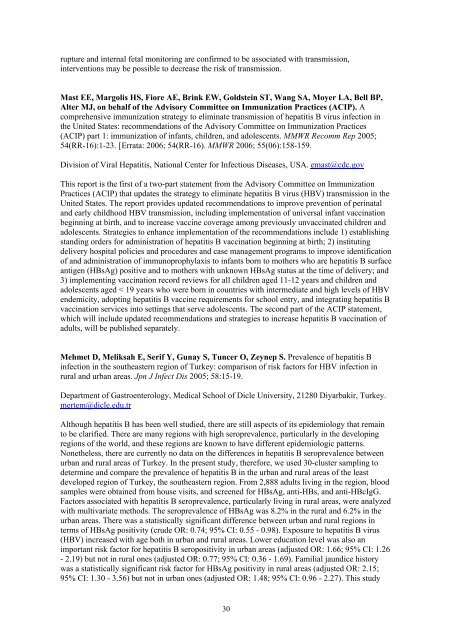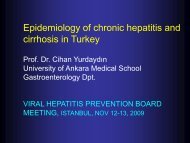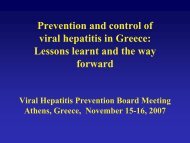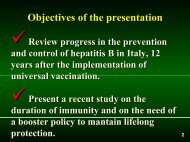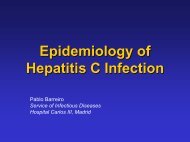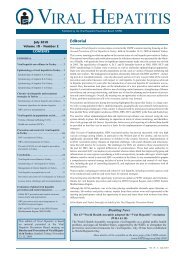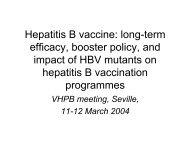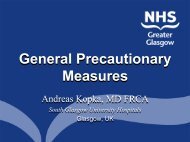upture <strong>and</strong> <strong>in</strong>ternal fetal monitor<strong>in</strong>g are confirmed to be associated with <strong>transmission</strong>,<strong>in</strong>terventions may be possible to decrease the risk <strong>of</strong> <strong>transmission</strong>.Mast EE, Margolis HS, Fiore AE, Br<strong>in</strong>k EW, Goldste<strong>in</strong> ST, Wang SA, Moyer LA, Bell BP,Alter MJ, on behalf <strong>of</strong> the Advisory Committee on Immunization Practices (ACIP). Acomprehensive immunization strategy to elim<strong>in</strong>ate <strong>transmission</strong> <strong>of</strong> <strong>hepatitis</strong> B <strong>virus</strong> <strong>in</strong>fection <strong>in</strong>the United States: recommendations <strong>of</strong> the Advisory Committee on Immunization Practices(ACIP) part 1: immunization <strong>of</strong> <strong>in</strong>fants, children, <strong>and</strong> adolescents. MMWR Recomm Rep 2005;54(RR-16):1-23. [Errata: 2006; 54(RR-16). MMWR 2006; 55(06):158-159.Division <strong>of</strong> Viral Hepatitis, National Center for Infectious Diseases, USA. emast@cdc.govThis report is the first <strong>of</strong> a two-part statement from the Advisory Committee on ImmunizationPractices (ACIP) that updates the strategy to elim<strong>in</strong>ate <strong>hepatitis</strong> B <strong>virus</strong> (HBV) <strong>transmission</strong> <strong>in</strong> theUnited States. The report provides updated recommendations to improve prevention <strong>of</strong> <strong>per<strong>in</strong>atal</strong><strong>and</strong> early childhood HBV <strong>transmission</strong>, <strong>in</strong>clud<strong>in</strong>g implementation <strong>of</strong> universal <strong>in</strong>fant vacc<strong>in</strong>ationbeg<strong>in</strong>n<strong>in</strong>g at birth, <strong>and</strong> to <strong>in</strong>crease vacc<strong>in</strong>e coverage among previously unvacc<strong>in</strong>ated children <strong>and</strong>adolescents. Strategies to enhance implementation <strong>of</strong> the recommendations <strong>in</strong>clude 1) establish<strong>in</strong>gst<strong>and</strong><strong>in</strong>g orders for adm<strong>in</strong>istration <strong>of</strong> <strong>hepatitis</strong> B vacc<strong>in</strong>ation beg<strong>in</strong>n<strong>in</strong>g at birth; 2) <strong>in</strong>stitut<strong>in</strong>gdelivery hospital policies <strong>and</strong> procedures <strong>and</strong> case management programs to improve identification<strong>of</strong> <strong>and</strong> adm<strong>in</strong>istration <strong>of</strong> immunoprophylaxis to <strong>in</strong>fants born to mothers who are <strong>hepatitis</strong> B surfaceantigen (HBsAg) positive <strong>and</strong> to mothers with unknown HBsAg status at the time <strong>of</strong> delivery; <strong>and</strong>3) implement<strong>in</strong>g vacc<strong>in</strong>ation record reviews for all children aged 11-12 years <strong>and</strong> children <strong>and</strong>adolescents aged < 19 years who were born <strong>in</strong> countries with <strong>in</strong>termediate <strong>and</strong> high levels <strong>of</strong> HBVendemicity, adopt<strong>in</strong>g <strong>hepatitis</strong> B vacc<strong>in</strong>e requirements for school entry, <strong>and</strong> <strong>in</strong>tegrat<strong>in</strong>g <strong>hepatitis</strong> Bvacc<strong>in</strong>ation services <strong>in</strong>to sett<strong>in</strong>gs that serve adolescents. The second part <strong>of</strong> the ACIP statement,which will <strong>in</strong>clude updated recommendations <strong>and</strong> strategies to <strong>in</strong>crease <strong>hepatitis</strong> B vacc<strong>in</strong>ation <strong>of</strong>adults, will be published separately.Mehmet D, Meliksah E, Serif Y, Gunay S, Tuncer O, Zeynep S. Prevalence <strong>of</strong> <strong>hepatitis</strong> B<strong>in</strong>fection <strong>in</strong> the southeastern region <strong>of</strong> Turkey: comparison <strong>of</strong> risk factors for HBV <strong>in</strong>fection <strong>in</strong>rural <strong>and</strong> urban areas. Jpn J Infect Dis 2005; 58:15-19.Department <strong>of</strong> Gastroenterology, Medical School <strong>of</strong> Dicle University, 21280 Diyarbakir, Turkey.mertem@dicle.edu.trAlthough <strong>hepatitis</strong> B has been well studied, there are still aspects <strong>of</strong> its epidemiology that rema<strong>in</strong>to be clarified. There are many regions with high seroprevalence, particularly <strong>in</strong> the develop<strong>in</strong>gregions <strong>of</strong> the world, <strong>and</strong> these regions are known to have different epidemiologic patterns.Nonetheless, there are currently no data on the differences <strong>in</strong> <strong>hepatitis</strong> B seroprevalence betweenurban <strong>and</strong> rural areas <strong>of</strong> Turkey. In the present study, therefore, we used 30-cluster sampl<strong>in</strong>g todeterm<strong>in</strong>e <strong>and</strong> compare the prevalence <strong>of</strong> <strong>hepatitis</strong> B <strong>in</strong> the urban <strong>and</strong> rural areas <strong>of</strong> the leastdeveloped region <strong>of</strong> Turkey, the southeastern region. From 2,888 adults liv<strong>in</strong>g <strong>in</strong> the region, bloodsamples were obta<strong>in</strong>ed from house visits, <strong>and</strong> screened for HBsAg, anti-HBs, <strong>and</strong> anti-HBcIgG.Factors associated with <strong>hepatitis</strong> B seroprevalence, particularly liv<strong>in</strong>g <strong>in</strong> rural areas, were analyzedwith multivariate methods. The seroprevalence <strong>of</strong> HBsAg was 8.2% <strong>in</strong> the rural <strong>and</strong> 6.2% <strong>in</strong> theurban areas. There was a statistically significant difference between urban <strong>and</strong> rural regions <strong>in</strong>terms <strong>of</strong> HBsAg positivity (crude OR: 0.74; 95% CI: 0.55 - 0.98). Exposure to <strong>hepatitis</strong> B <strong>virus</strong>(HBV) <strong>in</strong>creased with age both <strong>in</strong> urban <strong>and</strong> rural areas. Lower education level was also animportant risk factor for <strong>hepatitis</strong> B seropositivity <strong>in</strong> urban areas (adjusted OR: 1.66; 95% CI: 1.26- 2.19) but not <strong>in</strong> rural ones (adjusted OR: 0.77; 95% CI: 0.36 - 1.69). Familial jaundice historywas a statistically significant risk factor for HBsAg positivity <strong>in</strong> rural areas (adjusted OR: 2.15;95% CI: 1.30 - 3.56) but not <strong>in</strong> urban ones (adjusted OR: 1.48; 95% CI: 0.96 - 2.27). This study30
shows that the prevalence <strong>of</strong> HBV <strong>in</strong>fection <strong>in</strong> the southeastern region <strong>of</strong> Turkey is <strong>in</strong>termediateamong the levels reported for the European region <strong>of</strong> the World Health Orgnization.Meng J, Yue Y, Zhang S. Effect <strong>of</strong> <strong>in</strong>trauter<strong>in</strong>e <strong>hepatitis</strong> B <strong>virus</strong> <strong>in</strong>fection on <strong>hepatitis</strong> B vacc<strong>in</strong>e<strong>in</strong>oculation <strong>in</strong> newborns. Zhonghua Fu Chan Ke Za Zhi 2002; 37:136-138. [Article <strong>in</strong> Ch<strong>in</strong>ese]Department <strong>of</strong> Obstetrics <strong>and</strong> Gynecology, First Hospital <strong>of</strong> Xi'an Jiaotong University, Xi'an710061, Ch<strong>in</strong>a.The objective was to study the effect <strong>and</strong> the mechanism <strong>of</strong> peripheral blood nuclear cells (PBMC)<strong>in</strong>vaded by <strong>hepatitis</strong> B <strong>virus</strong> (HBV) on the artificial immunization <strong>in</strong> newborns. Fifty-twonewborns, whose mothers were <strong>hepatitis</strong> B surface antigen (HBsAg) positive, were immunizedwith <strong>hepatitis</strong> B immunoglobul<strong>in</strong> <strong>and</strong> <strong>hepatitis</strong> B vacc<strong>in</strong>e (HBVac), <strong>and</strong> then followed for 7months. The newborns' serum <strong>and</strong> PBMC HBV DNA was detected by nested-PCR, <strong>hepatitis</strong> Bsurface antibody (HBsAb) was tested with solid phase radioimmunoassay. PBMC from newbornwere <strong>in</strong>cubated with PHA <strong>and</strong> HBsAg. The supernatant <strong>in</strong>terleuk<strong>in</strong> 2 (IL-2) level was measured byenzyme l<strong>in</strong>ked immununosorbent assay (ELISA). The rate <strong>of</strong> vacc<strong>in</strong>ation failure was higher <strong>in</strong> the<strong>in</strong>fants with PBMC HBV DNA positive than those with negative (P < 0.05). The supernatant IL-2level was lower <strong>in</strong> the former than that <strong>in</strong> the latter <strong>and</strong> the <strong>control</strong> (P < 0.05). The level <strong>of</strong> IL-2 <strong>in</strong>the immunization failure newborns was lower than that <strong>in</strong> the vacc<strong>in</strong>ation success <strong>and</strong> the <strong>control</strong>(P < 0.05). The <strong>in</strong>trauter<strong>in</strong>e PBMC HBV <strong>in</strong>vasion is one <strong>of</strong> the important causes <strong>of</strong> vacc<strong>in</strong>ationfailure <strong>in</strong> the newborns. PBMC IL-2 autocr<strong>in</strong>e down regulation is closely related to HBV <strong>in</strong>vasion,that may lead to the failure <strong>of</strong> HBVac <strong>in</strong>oculation <strong>in</strong> the newborns.Milne A, West DJ, Ch<strong>in</strong>h DV, Moyes CD, Pörschke G. Field evaluation <strong>of</strong> the efficacy <strong>and</strong>immunogenicity <strong>of</strong> recomb<strong>in</strong>ant <strong>hepatitis</strong> B vacc<strong>in</strong>e without HBIG <strong>in</strong> newborn Vietnamese<strong>in</strong>fants. J Med Virol 2002; 67:327-333.The Hepatitis Foundation, Whakatane, New Zeal<strong>and</strong>. s<strong>and</strong>or<strong>and</strong>fay@extra.co.nzA study <strong>in</strong>volv<strong>in</strong>g more than 2,000 <strong>in</strong>fants was conducted <strong>in</strong> Vietnam to assess the fieldeffectiveness <strong>and</strong> immunogenicity <strong>of</strong> recomb<strong>in</strong>ant <strong>hepatitis</strong> B vacc<strong>in</strong>e given at birth, 1 month, 2months, without concomitant <strong>hepatitis</strong> B immune globul<strong>in</strong> (HBIg). All received a 5 microg dose <strong>of</strong>H-B-VAX II at birth. Infants born to non-carrier mothers (Group 1; N = 1798) then received 2.5microg doses at 1 <strong>and</strong> 2 months <strong>of</strong> age, while <strong>in</strong>fants <strong>of</strong> HBeAg-negative (Group 2; N = 125) orHBeAg-positive (Group 3; N = 88) carrier mothers received 5 microg doses. No Group 1 or 2vacc<strong>in</strong>ees were <strong>in</strong>fected. In Group 3, 12 (14.6%) <strong>of</strong> 82 <strong>in</strong>fants did become <strong>in</strong>fected (estimatedefficacy 84%). 98.0-98.6% <strong>of</strong> un<strong>in</strong>fected <strong>in</strong>fants who were tested for anti-HBs developed aseroprotective concentration > or = 10 IU/l. In hyperendemic Vietnam, where rout<strong>in</strong>e maternalscreen<strong>in</strong>g <strong>and</strong> passive-active prophylaxis <strong>of</strong> high-risk <strong>in</strong>fants with vacc<strong>in</strong>e plus HBIg is notfeasible, adm<strong>in</strong>istration <strong>of</strong> vacc<strong>in</strong>e alone to all newborns may <strong>control</strong> effectively HBV <strong>in</strong>fection.Nelson CM, Wibisono H, Purwanto H, Mansyur I, Moniaga V, Widjaya A. Hepatitis Bvacc<strong>in</strong>e freez<strong>in</strong>g <strong>in</strong> the Indonesian cold cha<strong>in</strong>: evidence <strong>and</strong> solutions. Bull World Health Organ2004; 82:99-105.Program for Appropriate Technology <strong>in</strong> Health, Seattle, WA 98107, USA. cnelson@path.orgThe objectives were to document <strong>and</strong> characterize freez<strong>in</strong>g temperatures <strong>in</strong> the Indonesian vacc<strong>in</strong>ecold cha<strong>in</strong> <strong>and</strong> to evaluate the feasibility <strong>of</strong> changes designed to reduce the occurrence <strong>of</strong> freez<strong>in</strong>g.Data loggers were used to measure temperatures <strong>of</strong> shipments <strong>of</strong> <strong>hepatitis</strong> B vacc<strong>in</strong>e frommanufacturer to po<strong>in</strong>t <strong>of</strong> use. Basel<strong>in</strong>e conditions <strong>and</strong> three <strong>in</strong>tervention phases were monitored.31
- Page 1 and 2: Pre-meeting documentPrevention and
- Page 3 and 4: Part I Prevention and control of pe
- Page 5 and 6: prevalence was significantly higher
- Page 7 and 8: clusters (obstetrics wards/hospital
- Page 9 and 10: Boxall E. Screening of pregnant wom
- Page 11 and 12: Chang MH, Hsu HY, Huang LM, Lee PI,
- Page 13 and 14: of infection in infants and childre
- Page 15 and 16: Eriksen EM, Perlman JA, Miller A, M
- Page 17 and 18: liver enzyme abnormalities than wer
- Page 19 and 20: health care, is feasible and achiev
- Page 21 and 22: HBsAg and anti-HBs in 4.5%. In the
- Page 23 and 24: immunoprophylaxis. Reflecting effec
- Page 25 and 26: Levin CE, Nelson CM, Widjaya A, Mon
- Page 27 and 28: Delaying vaccination of premature i
- Page 29: diagnosis. In the past, the inciden
- Page 33 and 34: Niu MT, Targonski PV, Stoll BJ, Alb
- Page 35 and 36: Ranger-Rogez S, Alain S, Denis F. H
- Page 37 and 38: vaccinees) and low reactogenicity o
- Page 39 and 40: single ELISA test is about Rs40. At
- Page 41 and 42: newborns with surface antigenemia,
- Page 43 and 44: Wang Z, Zhang J, Yang H, Li X, Wen
- Page 45 and 46: of hepatitis B vaccine. This study
- Page 47 and 48: transmission has been estimated at
- Page 49 and 50: at birth and 2 weeks after birth, f
- Page 51 and 52: Chubinishvili OV, Mikhailov MI, Sak
- Page 53 and 54: Jensen L, Heilmann C, Smith E, Want
- Page 55 and 56: Onishchenko GG. Incidence of infect
- Page 57: Zanetti A, Tanzi E, Semprini AE. He


